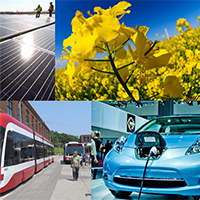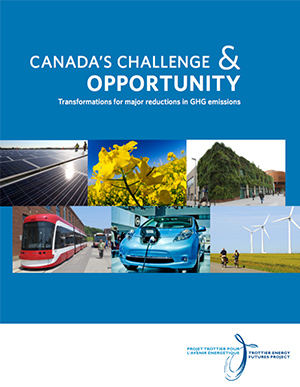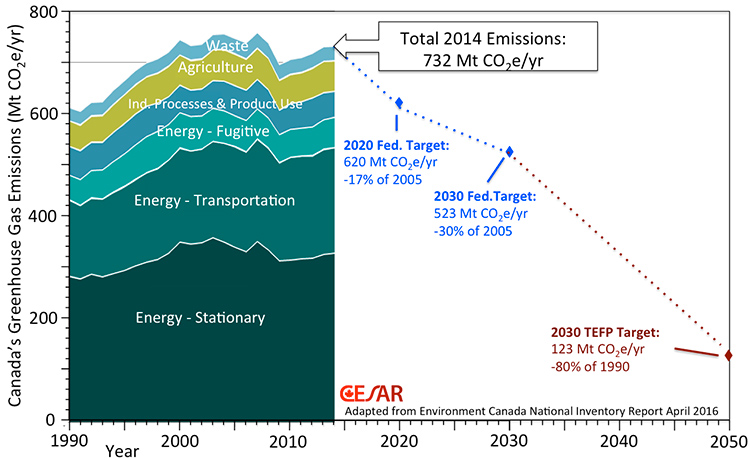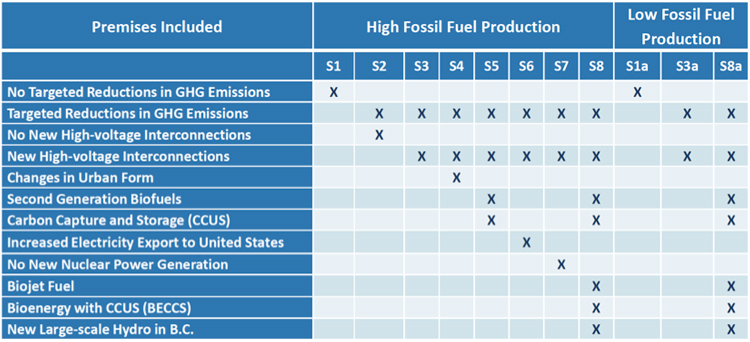Posted on Tue, 06/14/2016 - 06:38
By Mark Lowey

Canada has multiple options or ‘pathways’ for making deep cuts in greenhouse gas emissions over the next three decades, a new study using energy systems scenario modelling shows.

Click here to link to the TEFP Report.
However, the changes necessary to achieve deep reductions in carbon dioxide and other greenhouse gases will require a massive transformation of the country’s energy systems, and be associated with substantial costs. These costs generally exceed $100 per tonne of CO2e in the early years for all scenarios and increase over time to several hundred dollars per tonne (in 2011 dollars), the study says.
The objective of the Trottier Energy Futures Project was to define one or more pathways to 2050, with a goal of achieving an 80-per-cent reduction in greenhouse gas (GHG) emissions from 1990 levels.
In fact, the report did not include an 80-per-cent reduction scenario as it was deemed too costly, requiring either new cost-effective technologies that have not yet been developed, or systemic changes in the nature of Canada’s energy systems that were beyond the options considered in the study.
The message for policymakers, investors and all Canadians is: “Don’t underestimate the magnitude and complexity of this challenge,” says Oskar Sigvaldason, manager of the Trottier Energy Futures Project and president at SCMS Global.
“This challenge is complex and it will have a major impact on Canada’s economy. We’re dealing with massive, massive change.”
The Canadian Academy of Engineering and the David Suzuki Foundation teamed up to produce the 300-page report, Canada’s Challenge & Opportunity: Transformations for major reductions in GHG emissions – a comprehensive engineering analysis of Canada’s future energy systems. The study, meant to provide information for “informed public and policy discussion,” was supported by the Trottier Family Foundation, established by engineer, entrepreneur and philanthropist Lorne Trottier.
The Trottier Project study used systems analysis to analyze 11 separate scenarios with the goal of achieving the 80-per-cent GHG reduction by 2050, while continuing to meet growing energy demands in Canada.
“The systems analysis approach is a very powerful methodology for being able to break down an extremely complicated problem into components,” Sigvaldason says.
Systems analysis is a problem-solving process which is intended to provide better understanding of the behaviour of complex systems, and to serve as a basis for improved decision making, based on the merits of having access to better information. The essence of the approach is to separate the overall system into a series of component sub-systems. The behaviour of the overall system is then defined in terms of the combined behaviour of each of the sub-systems, as well as the behaviour of linkages between sub-systems.
Trottier Project researchers used two complementary mathematical models – an optimization model and a simulation model – to optimize and validate the scenarios modelled. The optimization model delivers a solution that satisfies the objective, which in this case was minimum cost to achieve progressive GHG reductions from 2011 to 2050. As noted above, the study fell short of meeting the 80-per-cent GHG reduction goal given the study’s parameters.
“The most important contribution from the Trottier Project is that we have established comprehensive, rigorous analytical bases that should serve as a very valuable basis for making the best decisions to address the climate change challenge,” Sigvaldason says. “This really allows people to understand what a minimum-cost solution looks like for the system as we have described it.”
In guiding strategic and investment decisions in Canada’s future energy systems, “The first principle is to select those strategies that achieve maximum improvement at minimum cost,” he adds. “In that sense, the models can be extremely helpful, to show where the most promising opportunities are.”
The simulation model was used, among other things, to define important inputs for the optimization model and for projecting population growth, gross domestic product (GDP) per capita, total GDP, and industrial gross output to 2050. The model provides more detailed results for any combined set of system definition and decisions. For its simulation model, the Trottier Project study used the Canadian Energy Systems Simulator (CanESS) model developed by Ottawa-based whatIf? Technologies Inc. The CanESS model, which integrates multiple sets of data, can produce system responses on a year-by-year basis, as well as, in most cases, more detailed evaluation of results for the various technologic and strategic options. This is the same powerful modelling tool that CESAR uses in its scenario modelling research.
The North America TIMES Energy Model (NATEM-Canada) was used as the optimization model in the Trottier Project. This model systematically screens many combinations of technologies and development options, assessing their costs and benefits over time with a goal of identifying the lowest cost strategy to meet ambitious GHG reduction targets.

Figure 1. Canada’s greenhouse gas (GHG) emissions from 1990 to 2014, showing federal (Fed.) targets for 2020 and 2030, as well as the Trottier Energy Futures Project (TEFP) Target for 2050. This figure was adapted by CESAR from a figure in the Environment Canada National Inventory Report in April 2016.
The Trottier Project study notes that the Intergovernmental Panel on Climate Change (IPCC) 2014 Synthesis Report states that “substantial [greenhouse gas] emissions reductions over the next few decades can reduce climate risks in the 21st century and beyond, increase prospects for effective adaptation, reduce the costs and challenges of mitigation in the longer term, and contribute to climate-resilient pathways for sustainable development.”
“When you go through the IPCC report, the 80-per-cent GHG reduction target is only a milestone,” Sigvaldason says. “You’re really got to get to 100-per-cent reduction-plus,” because carbon dioxide persists in the atmosphere, elevating the average global temperature for centuries. “So it’s not just a question of getting to zero emissions – you have to get way beyond zero. This is a huge challenge.”
Canada, in the Paris Agreement reached in December at the United Nations’ COP 21 international climate conference, pledged to reduce GHG emissions in 2030 by 30 per cent of Canada’s 2005 emissions level. Achieving an 80-per-cent GHG reduction by 2050 would require reducing Canada’s GHGs to just 123 megatonnes (Mt) by 2050, compared with 613 Mt in 19901 (Figure 1). Canada’s GHG emissions in 2014 were 732 Mt and, without any new actions to curb emissions, are projected by the Trottier Project modelling to increase to 1,109 Mt by 2050.
Costs of reaching the goal
The Trottier Project study is based on two quantitative models for combustion emissions that have been calibrated using historical data. These models calculated GHG emissions in Canada from combustion to the year 2050 using a variety of scenarios, as well as a defined set of energy technologies. The models also calculated “marginal cost” for the projected energy system transformations, in the form of equivalent carbon prices over time for each scenario.
For most scenarios, the approach was based on currently deployed technologies with plausible extrapolations for future improvements and cost reductions. “The main value of this project is that it shows what is possible with current technology,” the report says.
In every scenario (except the reference scenario, in which no new measures are taken to curb emissions), the costs of achieving the 80-per-cent GHG-reduction goal are substantial. “The cost that people have been talking about, like $15 or $30 a tonne CO2e, will get you a little ways, but it will not get you to 80-per-cent,” Sigvaldason says. Instead of tens of dollars per tonne of CO2e, people should be thinking in terms of hundreds of dollars per tonne, he says. For comparison, Alberta’s carbon levy will reach $30 per tonne CO2e in 2018 while British Columbia’s current carbon tax is $30 per tonne.
Sigvaldason cautions that the very high costs projected by 2050 in the various scenarios are unlikely to occur because there will be changes affecting Canada’s energy systems over the next three decades. This could include new and improved or unforeseen technologies, more cost-efficient energy use and production, and new policies. “The cost will go up over time, but it may not go up to $1,000 or $2,000 per tonne CO2e,” he says. “The rate of innovation just keeps accelerating, and there will be technologies or solutions or changes in lifestyle that will happen between now and 2050, which will lead to a situation which is much different than we might realistically assume today on the basis of the best possible information.”
The scenarios or pathways described in the Trottier Project study also could be more economically attractive when the co-benefits are considered, such as improved public health, traffic management and infrastructure life-cycle costs, the report says. Nonetheless, estimates by some experts that achieving an 80-per-cent GHG reduction goal by 2050 could cost two to three per cent of Canada’s GDP are reasonable.
Pathways to achieving deep GHG cuts
Canada’s GHG emissions in 2014, as reported in annual National Inventory Reports, amounted to 732 Mt CO2e annually. Seventy-three per cent of these emissions came from the combustion of fossil fuels (fossil fuel production, transport, electricity, industrial, residential, commercial and agriculture) and 27 per cent from non-combustion sources (industrial processes, fugitive emissions, waste and agriculture processes).
Eight of the 11 scenarios in the Trottier Project study involve high fossil fuel production and assume no constraints on the exports of fossil fuels. Three low fossil fuel production scenarios assume lower demand for Canadian energy exports and a proportionate reduction in fossil fuel consumption based on concerted global action to reduce GHG emissions. The first scenario is a reference scenario in which Canada takes no additional measures targeted at reducing GHGs. All subsequent scenarios, except one, incorporate targets for GHG reductions that start at 30 per cent and increase to 60 per cent (and in one scenario 70 per cent). No scenario was able to achieve the 80-per-cent target set out by the project.
Seven of the high fossil fuel production scenarios explore options for reducing GHG emissions, starting with proven technologies and adding promising but not yet commercial ones, such as second-generation biofuels and carbon capture, use and storage. One of these scenarios assumes no new nuclear generating capacity is installed, beyond existing planned refurbishments. Six of the seven scenarios assume there are no barriers to interjurisdictional sharing of electricity among the 10 provinces and three territories. The three low fossil fuel production scenarios include results from reduced use of fossil fuels in Canada and reduced export, based on the premise that there are corresponding worldwide reductions in the use of fossil fuels. To be able to actually achieve the 80-per-cent GHG reduction target by 2050, “Continued production of these fuels is not likely to be economically feasible unless there is a breakthrough in low-cost extraction with greatly reduced emissions,” the report says.

Table 1. Overview of the 11 scenarios that were modelled in the Trottier Energy Futures Project. (From Kathleen Vaillancourt’s presentation on the TEFP results, Ottawa, May 2016).
The most aggressive scenario in the Trottier Project study occurs with lower global fossil fuel demand and correspondingly lower production and export by Canada. This scenario results in a 70-per-cent reduction in combustion emissions, from 425 Mt in 1990 to 128 Mt in 2050. “Very large increases in electricity and biomass/biofuels use occur as a result,” the report says. The aggressive scenario includes using proven technologies, such as hydro, nuclear and wind power, as well as technologies that aren’t yet commercially available, such as second-generation biofuels, coal-fired thermal power plants retrofitted with carbon capture and storage, and bioenergy production with carbon capture and storage. In addition, the scenario projects 122 gigawatts of new large-scale hydro power and new nuclear power generation, including 21 to 85 gigawatts in Alberta, depending on how much fossil fuels production and export are reduced by 2050. Substantial reductions in GHG emissions occur in all five end-use sectors, and rapid decarbonization of electricity supply also occurs by 2030. By 2050, the three sectors still producing significant GHG emissions include transportation, industry and fossil fuel supply.
To achieve deep cuts in GHG emissions, emissions-free electricity will need to play a much bigger role in Canada’s future energy systems. The aggressive scenario shows a 45-per-cent increase in electricity production between 2011 and 2030, while conventional thermal generation declines by 48 per cent. There is a projected 76-per-cent jump in hydro generation and a 3.5-fold increase in intermittent renewables generation (mainly by wind), along with introduction of biomass-based generation combined with carbon capture, utilization and storage by 2030. In the transportation sector, the use of electricity and biofuels increases to 18 per cent by 2030, from three per cent in 2011.
“In 2050, the use of electricity is pervasive in meeting the energy needs of homes, offices and factories,” the report says. “Families drive electric cars or make use of expanded electric public-transit networks, heavy-duty transport trucks are powered by biofuels (or other low-carbon technologies), and promising approaches to replacing jet fuel with biojet fuel are becoming commercially viable. Carbon capture and storage techniques ensure that GHG emissions from the burning of fossil fuels are contained.”
The aggressive scenario also projects a large increase in ‘green’ electricity, including 30 gigawatts of additional hydro power in British Columbia that gets built within 15 years. “But practically, it really is not achievable,” Sigvaldason says. Rather, the scenario is “a demonstration of the importance of moving quickly and recognizing that if you have delays, you’re going to have more expensive solutions,” he adds.
Today, 74 per cent of end uses of energy are based on fossil fuel derivatives. Achieving the 80-per-cent reduction in GHG emissions will require lowering these end uses of fossil fuel to 25 per cent or less. “The fossil fuel industry has a huge challenge,” but it has more than three decades until 2050 to meet that challenge, Sigvaldason says. Companies need to adapt and evolve from the core business they have now “to being something that’s different, maybe moving more into renewables or moving into more efficient energy systems.” The industry also has to look at the technology options for fossil fuels that could transform the role of fossil fuels in meeting society’s end uses, such as in the transport, electricity, residential and commercial sectors.
Priorities for action
The Trottier Project report says that substantial progress can be made by 2030 using currently available technologies to reduce GHG emissions. Key priorities include:
Significantly increasing the supply of electricity and biomass/biofuels in order to displace fossil fuels in all five end-use sectors.
“This recognizes the fact that when you look at the GHG emissions that come from wellhead to burner tip, it’s only 15 per cent of the GHGs that are emitted through the entire supply chain process (extracting, collecting, upgrading, refining, transporting and distributing fossil fuels to end-users), while 85 per cent is from end-use ‘consumption’ (e.g. burning gasoline in your car or natural gas in your home for heating),” Sigvaldason says.
One promising area for reducing the burning of fossil fuels for end use is the electrification of the transport sector, especially cars and light-duty trucks for personal use, he adds. Other opportunities lie in the residential and commercial sectors, including switching from natural gas for space heating to other options (e.g. electric baseboard heaters and other electric heaters) and using more heat pumps and passive solar systems.
Decarbonizing electricity production by switching to non-emitting sources, enabling transfers of electricity between provinces and territories.
The study’s analysis shows “this is one of the most cost-effective options for quickly reducing combustion emissions,” the report says. It can be accomplished by replacing existing fossil fuel-fired generating facilities (predominantly coal and natural gas) with low-carbon facilities, and by installing high-voltage interconnections between jurisdictions, especially to enable transfers of electricity between provinces and territories that have an abundance of hydroelectric capacity and associated storage with those that do not.
Implementing a comprehensive program of energy conservation and efficiency measures.
Depending on the scenario, energy conservation measures could, for example, eliminate as much as 60 per cent of the demand for space heating in the commercial sector and as much as 40 per cent in the residential sector, the report says. However, “There are a lot of institutional barriers that are impeding the ability to realize these benefits, some of which are even achievable at negatives costs,” Sigvaldason says, adding that new codes and standards will be required to achieve the desired levels of energy conservation and efficiency.
Challenges
The study identified a number of significant challenges which, if they remain unaddressed, will make achieving deep reductions in GHG emissions very difficult, the report says. Further investigation and assessment are needed in these areas:
- The development and deployment of second-generation biofuels, especially for use in heavy freight and rail transport;
- In-depth analysis of options for reducing GHG emissions from industrial combustion and non-combustion sources;
- A comprehensive program of data collection and analysis to assess the full magnitude of the fugitive emissions problem and to identify mitigation approaches;
Fugitive emissions, which made up nine per cent of Canada’s total GHG emissions in 2010, come from the intentional or unintentional release of GHGs from production, processing, storage and delivery of fossil fuels – including venting and flaring at facilities that process natural gas and oil. The study found that less than 10 per cent of reported fugitive emissions in Canada are flared, while the rest is simply vented. Reported fugitive emissions could be reduced by at least 50 per cent, while the actual volume of fugitive emissions – which is underreported – could be reduced by 60 to 80 per cent, the report says. By doing so, “It is considered that there is significant potential for associated economic benefits,” according to the report.
- Accelerated research on ways to reduce GHG emissions from oil and natural gas production, upgrading and refining, including fuel switching and process changes;
- Further work on the extent to which improved urban form can reduce overall infrastructure costs and related GHG emissions, and on promising GHG reduction approaches, such as public transit, co-generation, distributed generation, district heating, waste-to-energy, and local energy storage;
- Research on ways to achieve net-negative GHG emissions, including biomass electricity generation with carbon capture and storage, increased use of wood products for carbon retention in buildings, and carbon sequestration through afforestation and reforestation;
- Recognition that consultations with decision-makers, communities and First Nations will need to occur for the envisioned pathways to come to pass.
Opportunity
Canada is positioned to be one of the very few countries that can produce emissions-free electricity at a globally competitive cost, the report says. Opportunities will arise for the manufacturing of energy-intensive products for export, especially from Canadian jurisdictions that can produce low-cost, emissions-free electricity. Electricity exports to the U.S. could increase and could include the sale of “dependable capacity” to selected neighboring American jurisdictions.
With the greatly enhanced potential role for the use of biomass and biofuels, both the forestry and agricultural sectors would see opportunity in providing energy commodities (biomass and first- and second-generation biofuels) and in carbon retention, including afforestation, improved forest management and the production of harvested wood products, the report says.
For those sectors involved in the production, processing and transport of fossil fuels, opportunities will open for those who find ways to use these products with greatly reduced emissions using cost-effective techniques for carbon capture, use and storage or for producing low-maintenance, carbon-based storage products.
“If there’s a disruptive technology that comes along in which you can actually use the energy from fossil fuels and not emit any CO2, then that is a pretty dramatic impact. It would change everything,” Sigvaldason says.
Is the 80-per-cent goal realistically achievable?
The results from even the most aggressive scenario show significant progress on GHG emission reductions, but they fall short of the 80-per-cent reduction goal. “Achieving this may require the use of “net-negative” emission strategies well before 2050, the report says. These could include GHG sequestration with afforestation and reforestation, in addition to using bioenergy with carbon capture and storage and implementing a comprehensive harvested wood-products program.
The results from the study also cast “considerable doubt” about the timely availability of technology and associated infrastructure, the report says. Deep GHG reductions will affect all Canadians and will therefore necessary involve changes in lifestyle. “The results also speak to a requirement for carbon pricing and supporting regulation. The accomplishment of the societal transformations involved in reducing GHG emissions by 80 per cent or more will require leadership from all sectors of society, and will require Canadians to develop a widely shared vision of low-carbon lifestyles and energy systems,” the report says.
“There has to be a genuine sense of urgency that this problem is really huge and we just have to get going,” Sigvaldason says. He points to the United Kingdom, which passed climate change legislation in 2008 that required an 80-per-cent reduction in GHGs by 2050, and created a department of energy and climate change to deliver on that goal. The UK took that action without knowing how the nation would actually achieve the goal, he notes. “It was an act of faith.” The government established carbon budgets for every five-year period, and is currently focused on the carbon budget for the period from 2028 to 2032, and on implementing the policy measures to deliver on that budget. The UK continues to look at models, technological development and fundamental changes. “But they are still fully committed to achieving the 80-per-cent reduction by 2050.”
“We have started to take action in Canada,” Sigvaldason says. “And we have to really speed up if there is going to be any chance for delivering on COP 21 and subsequent commitments.”
Footnotes
1 The emissions numbers for Canada cited in this blog may differ slightly from those in the Trottier report since they were drawn from the most recent National Inventory Report for Canada, published in April 2016.
